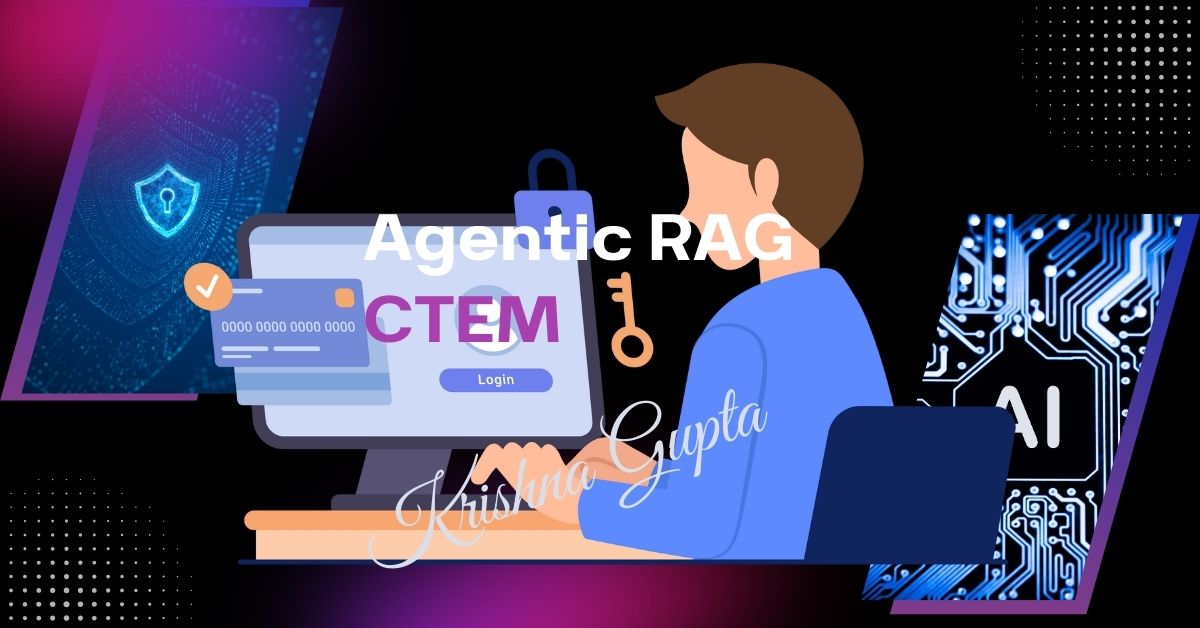Agentic RAG in CTEM: Reimagining Continuous Threat Exposure Management with Autonomous Intelligence
Executive Summary
In the ever-evolving cyber threat landscape, Continuous Threat Exposure Management (CTEM) has emerged as a strategic discipline to proactively identify, assess, and mitigate risks before adversaries can exploit them. However, as CTEM frameworks grow in complexity and scale, the traditional approaches to risk visibility and mitigation lag behind. Enter Agentic RAG—a blend of agentic AI and the Red-Amber-Green (RAG) framework—transforming how security leaders manage and visualise risk across dynamic environments.
This blog post explores how Agentic RAG enhances CTEM capabilities by enabling self-directed agents to evaluate threats autonomously, prioritise responses using colour-coded cues, and integrate intelligence into organisational workflows.
1. Introduction to CTEM
Continuous Threat Exposure Management (CTEM) is not a tool or platform but a strategic programme that integrates threat intelligence, attack surface management, vulnerability prioritisation, and validation techniques like red teaming or breach simulation.
Gartner defines CTEM as a 5-stage maturity model:
- Scoping
- Discovery
- Prioritisation
- Validation
- Mobilisation
The goal is continuous validation of security posture against real-world threats. However, manual processes and siloed tools create bottlenecks—especially when real-time action is needed.
2. What is Agentic RAG?
Agentic RAG combines:
- Agentic AI: Autonomous AI systems capable of making decisions, initiating actions, and learning over time—without constant human prompts.
- RAG Framework: The Red-Amber-Green model used for categorising and prioritising risk exposure levels.
Why “Agentic”?
Unlike traditional AI, agentic systems have goal-oriented autonomy, situational awareness, and collaborative decision-making traits. Think of them as proactive digital analysts embedded in your CTEM loop.
3. The Intersection of Agentic RAG and CTEM
Real-time Exposure Mapping
Agentic RAG bots can:
- Continuously scan environments
- Cross-reference external threat intel feeds
- Classify vulnerabilities or misconfigurations using the RAG colour scale:
- 🔴 Red: Critical threat, exploitation active
- 🟠 Amber: Medium severity, possible exploitation path
- 🟢 Green: Safe or already mitigated
Actionable Intelligence Loops
The AI agents not only identify the issue but also recommend or even execute remediation steps—from patch management to firewall rule adjustments, based on predefined rules or learned behaviour.
4. Key Use Cases of Agentic RAG in CTEM
| Use Case | Agentic RAG Functionality | Business Impact |
| External Attack Surface Management | Bots identify new exposed assets, tag risk levels with RAG colour scheme | Prevent brand reputation damage |
| Cloud Misconfiguration Monitoring | Continuously assess cloud permissions, keys, IAM roles | Avoid data breaches and compliance fines |
| Ransomware Readiness Validation | Simulate lateral movement and prioritise defence gaps in red category | Reduce attack blast radius |
| CVE Prioritisation | Evaluate active exploitability and assign RAG for patch urgency | Optimise vulnerability management budget |
| Third-party Risk Scoring | Agents pull dark web signals on suppliers and classify risk | Avoid supply chain compromise |
5. Implementation Blueprint for C-Suite Leaders
Phase 1: Strategic Scoping
- Identify key business units and assets to include in the Agentic RAG analysis loop.
- Collaborate across IT, security, and compliance teams to define risk appetite thresholds.
Phase 2: Agentic Integration
- Deploy agentic AI frameworks within your CTEM stack (e.g. combining SOAR, ASM, and VA tools).
- Configure RAG thresholds based on business-criticality and regulatory requirements.
Phase 3: Feedback Loops and Learning
- Use reinforcement learning to improve agents’ decision quality.
- Enable auto-reporting to dashboards and alerting tools (like Splunk or Microsoft Sentinel).
6. Risks, Challenges, and Mitigation Strategies
| Challenge | Mitigation Strategy |
| Overdependence on automation | Maintain human-in-the-loop for critical systems |
| Inconsistent RAG thresholds | Standardise RAG scoring using business context |
| False positives due to AI misclassification | Implement multi-agent consensus before alerts/actions |
| Integration fatigue | Start with low-friction modules like CVE triage agents |
7. ROI of Agentic RAG in CTEM
Tangible ROI
- 40% faster vulnerability triage cycles
- Reduced mean time to remediation (MTTR) by up to 60%
- Savings on outsourced red-teaming engagements
Intangible ROI
- Board-level visibility through real-time RAG dashboards
- Boosted executive confidence in cybersecurity readiness
- Reinforced culture of proactive cyber resilience
8. Future Outlook: Agentic CTEM 2.0
- Multi-agent collaboration: Swarms of agents coordinating across hybrid environments.
- Natural language reasoning: Agents explain RAG scoring to CISOs in plain English.
- Quantum-secure CTEM: Agentic AI validating quantum-resistant configurations.
Agentic CTEM 2.0 will mark a shift from reactive security hygiene to self-healing infrastructures.
9. Final Thoughts
CTEM is the future of proactive cybersecurity—but it needs automation supercharged with context-aware, autonomous decision-making. Agentic RAG fills this critical gap.
By fusing real-time exposure mapping, autonomous risk classification, and actionable intelligence, Agentic RAG transforms CTEM from a reactive workflow into a living, breathing digital immune system.

The boardroom takeaway? You don’t just need more data—you need smarter agents who know what to do with it.
10. Executive Checklist: Deploying Agentic RAG in CTEM
✅ Identify core CTEM components that require automation
✅ Define business-aligned RAG thresholds
✅ Integrate agentic AI in exposure scanning and validation
✅ Ensure explainability and governance in decision outputs
✅ Monitor, refine, and retrain agents continuously
✅ Measure outcomes through MTTR, CVE closure rate, and RAG visualisation coverage